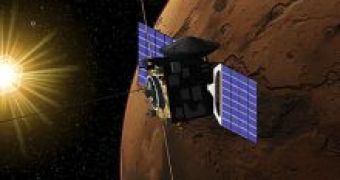The solar eclipses experienced by the Mars Express spacecraft orbiting the red planet are caused either by Mars or by Earth, occasionally blocking the Sun in their motions. In the past weeks, from end-August until late September, the probe, which is powered by solar energy, has experienced an unusually demanding solar eclipse season.
The spacecraft completes one orbit around Mars quite fast, in approximately 6 hours, but in spite of its speed, it has now experienced "blackouts" even as long as 75 minutes. During these eclipses, the solar panels generate no power and the spacecraft has to run on battery power alone. To face this challenging period, the craft entered an ultra-low-power mode necessary to ensure spacecraft survival. The power mode was called "Sumo", for "survival mode".
Moreover, Mars is now farthest away from the Sun and the solar power has dropped by 20 percent. The problem faced by Mars Express was that the eclipses happened too close to one another and the batteries didn't have enough time to recharge. This meant that the probe was in danger of losing all power.
"This was potentially critical, and we knew we had to devise a solution that wasn't in the manual," said Michel Denis, Spacecraft Operations Manager based at ESOC, ESA's Space Operations Centre, in Darmstadt, Germany.
To solve the problem, most of the on-board devices were switched off, including all science instruments, or powered down and the space craft was turned in such a way to face the Sun and to collect the maximum amount of energy possible. However, this power gathering position meant that Mars Express was to be turned away from Earth, temporarily cutting the communication with ground control. This was not a type of operation envisioned when Mars Express was built.
The scientists started to plan the "sumo" operation in 2005 and finished in May 2006. This involved a lot of close teamwork and also some engineering innovations. They had not only to predict exactly how the eclipses would happen but also to take into consideration how various devices on board influenced one another. For example, they figured out how some components could use the heat emitted by nearby devices so they wouldn't freeze up permanently. This allowed the powering down of the heaters.
"We created Sumo mode from scratch, and it is a careful balance based on the total energy consumption tally that would enable Mars Express to survive," said Denis.
"Sumo mode was also innovative in that it preserved precious fuel, providing a wide range of options for future science-enhancing maneuvers," added Fred Jansen, ESA Mission Manager for Mars Express.
Mars Express entered Sumo on 23 August. The blackouts started on 29 August, and the height of the eclipse season was reached on 9 September, when the orbital blackouts lasted up to 75 minutes. The extra-long eclipse season ended on 17 September and Mars Express has emerged with all systems still working.
"We've learned a lot about power management and we can apply these lessons not only to Mars Express during the rest of the mission but also to other missions," said Denis. "For future eclipses, we are now even stronger."

 14 DAY TRIAL //
14 DAY TRIAL // 
